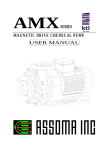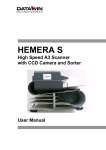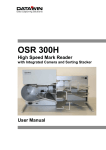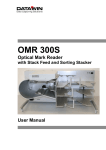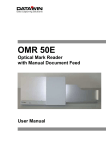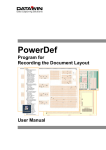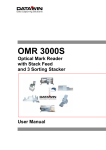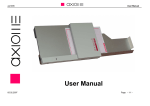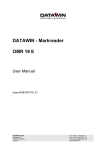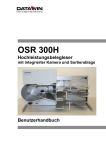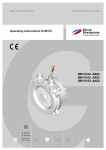Download User manual OMR 200S English Date: 11/2006 | Size
Transcript
OMR 200S Optical Mark Reader with Stack Feed User Manual Publisher: DATAWIN GmbH Etzstraße 37 D-84030 Ergolding Tel. : + 49 (0)871-43 05 99 0 Fax: + 49 (0)871-43 05 99 29 E-Mail: [email protected] Web: http://www.datawin.de Printed in Germany Subject to alteration Windows is a registered trademark of the Microsoft Corporation. Copyright © DATAWIN GmbH All rights reserved This manual is the intellectual property of DATAWIN GmbH. Unauthorized use, duplication or distribution are prohibited. Any reproduction of the contents of this manual, in whole or in part, without written permission of DATAWIN GmbH is forbidden. Edition October 2006/1.2 DATAWIN GmbH OMR 200S – User Manual 2 Table of Contents 1 1.1 1.1.1 1.2 1.2.1 1.2.2 1.3 1.3.1 1.3.2 1.3.3 Introduction .................................................................................................... 1-1 About this manual............................................................................................. 1-1 Typographical notes ......................................................................................... 1-1 Information about unpacking the mark reader................................................... 1-2 Unpacking the optional sorting tray................................................................... 1-3 Scope of the delivery ........................................................................................ 1-4 Device related safety information...................................................................... 1-5 Conformity ........................................................................................................ 1-5 Precautionary measures for transportation, storage and installation ................. 1-5 Selection of the work site.................................................................................. 1-5 2 2.1 2.2 2.2.1 2.2.2 2.2.3 2.2.4 2.2.5 2.2.6 The OMR 200S optical mark reader............................................................... 2-1 Functional components..................................................................................... 2-1 Document processing – from intake to output ................................................... 2-3 Automatic document intake............................................................................... 2-3 Transport path .................................................................................................. 2-4 Read stations ................................................................................................... 2-4 Document output .............................................................................................. 2-5 Optional sorter .................................................................................................. 2-5 Optional printer ................................................................................................. 2-6 3 3.1 3.2 3.3 3.4 3.5 3.5.1 3.5.2 3.6 3.6.1 3.6.2 3.7 3.8 Assembling and installing the reader ........................................................... 3-1 Assembling the standard output tray................................................................. 3-1 Assembling the optional sorter.......................................................................... 3-2 Mains connection data...................................................................................... 3-3 Data interface ................................................................................................... 3-3 PC connection .................................................................................................. 3-4 Minimum requirements on the PC..................................................................... 3-4 Connecting the reader and the PC.................................................................... 3-4 Software ........................................................................................................... 3-5 Interface firmware............................................................................................. 3-5 Read software .................................................................................................. 3-5 Testing the read functions ................................................................................ 3-5 De-installing the reader..................................................................................... 3-5 4 4.1 4.2 4.2.1 4.3 4.3.1 4.3.2 4.4 Operation of the reader .................................................................................. 4-1 Loading the stack of documents ....................................................................... 4-1 Starting the read process.................................................................................. 4-1 Display of the operating status.......................................................................... 4-2 Eliminating document jams ............................................................................... 4-3 Opening and closing the scanner cover ............................................................ 4-3 Removing documents ....................................................................................... 4-4 Trouble shooting............................................................................................... 4-5 5 5.1 Setting, adjusting and cleaning the reader ................................................... 5-1 Setting the OMR read head .............................................................................. 5-1 DATAWIN GmbH OMR 200S – User Manual 3 5.1.1 5.1.2 5.1.3 5.1.4 5.2 5.3 5.4 5.5 5.6 5.7 5.8 5.8.1 5.8.2 5.8.3 5.8.4 Basic setting "standard document" ................................................................... 5-1 Adjusting the lateral setting of the OMR read head........................................... 5-2 Adjusting the lateral setting of the lower OMR read head (option) .................... 5-3 Effect of the read head setting on the scanning result....................................... 5-4 Setting the bar code read head......................................................................... 5-5 Replacing the disks of the feed rollers .............................................................. 5-6 Replacing the rings of the intake rollers ............................................................ 5-6 Setting the document isolation.......................................................................... 5-7 Cleaning the document transport path .............................................................. 5-9 Replacing ink cartridges in the optional printer................................................ 5-10 General information on cleaning the OMR 200S............................................. 5-11 Cleaning the transport rollers.......................................................................... 5-11 Cleaning the light barriers............................................................................... 5-12 Cleaning the read windows of the OMR and of the bar code read heads........ 5-12 Cleaning the housing surface ......................................................................... 5-12 6 6.1 6.2 6.2.1 6.2.2 6.2.3 6.2.4 6.3 6.3.1 6.3.2 6.3.3 6.3.4 Requirements on the documents .................................................................. 6-1 External characteristics..................................................................................... 6-1 Prescriptions and recommendations concerning OMR marks........................... 6-2 The mark field................................................................................................... 6-2 Correct marks................................................................................................... 6-3 Marking errors .................................................................................................. 6-3 Reliable marking instruments............................................................................ 6-4 DATAWIN OMR document specifications ......................................................... 6-5 Standard document .......................................................................................... 6-5 Scanning window.............................................................................................. 6-7 Bar codes labels and imprints........................................................................... 6-8 Permissible document colors for red light and infrared light scanning ............... 6-9 DATAWIN GmbH OMR 200S – User Manual 4 1 Introduction 1.1 About this manual This manual is intended for users who are entrusted with the setting up, installation and operation of the OMR 200S optical mark reader (OMR = Optical Mark Recognition). • Part 1 provides information about – unpacking and storing the device and device related safety information – connection to the mains source and authorization as well as – the requirements on the operating environment. • Part 2 informs you about the main mode of operation. • Part 3 describes – the assembly of the document output tray and – the installation of the OMR 200S – from connection to the PC up to conducting a test run. • Part 4 provides tips and information to facilitate faultless operation of the OMR 200S. • Part 5 shows how you can increase the reading reliability: – by mechanical adjustments in the reader and – by a simple cleaning procedure of the OMR 200S. • Part 6 describes the requirements on the documents to be processed. 1.1.1 Typographical notes Ị This symbol calls your attention to particular items that absolutely must be observed. ♦ This symbol always appears before process sequences and it simultaneously indicates the chronological sequence. DATAWIN GmbH OMR 200S – User Manual 1-1 1.2 Information about unpacking the mark reader The two small boxes inside the cardboard box contain accessories and the document output tray. If the reader was delivered with the optional sorting tray instead of the simple output tray, the sorter is packed separately. ♦ Grasp the reader by the filling materials mounted on the left and right sides of the device and lift it carefully, straight upwards out of the cardboard box without tilting it. The device weighs about 11 kg. ♦ Set the reader down vertically on the intended work surface with the intake tray towards the top. Remove the two pieces of filling material on the sides, one after the other, and place the reader on its feet (round adjustable feet). Ị Caution! When setting up the reader, take care not to grasp the device at the top near the (closed) scanner cover nor at the intake tray; only grasp it at the back housing cover and below at the base plate. The scanner cover is not locked! It could swing open dangerously which might result in the device falling out of your hands onto the work surface! DATAWIN GmbH OMR 200S – User Manual 1-2 ♦ Remove the output tray from the packaging and place it to the right of the reader on the work desk. You can read about how to assemble the reader and the output tray in section 3.1. 1.2.1 Unpacking the optional sorting tray The optional sorting tray with two output compartments is delivered in its own packaging. ♦ Remove the upper piece of filling material. ♦ Grasp the sorting tray at the ejection mechanics between the two sorting compartments and lift it out of the packaging. This device weighs 2.6 kg. Ị When lifting out the sorting tray, please do not grasp it at the upper cover of the sorting drive since this might cause misalignment of the ejection mechanics. ♦ DATAWIN GmbH OMR 200S – User Manual 1-3 Place the sorting tray to the right of the reader on the work desk. You can read about how to assemble the reader and the output tray compartments in section 3.2. Ị Save the entire original packing for later transportation and shipping of the mark reader and the sorting tray. Devices that are sent back to suppliers for maintenance or repair work are always returned in their original boxes (possibly at cost of the sender). 1.2.2 Scope of the delivery Check to make sure that the delivery is complete. All accessories required for the connection and operation of the OMR 200S are included in the delivery: – – – mains cable data cable CD ROM with installation software and manual If something is missing or if damages occurred during transportation, please contact your supplier. DATAWIN GmbH OMR 200S – User Manual 1-4 1.3 Device related safety information 1.3.1 Conformity The OMR 200S reader conforms to the CE standards and guidelines for data processing devices (design according to VDE 0805/5.90, interference suppression according to VDE 0871-B). It can be operated continuously under normal room conditions. 1.3.2 Precautionary measures for transportation, storage and installation Please observe the following points regarding the transportation and installation of the reader: Transportation and storage Ị Transportation of the reader should only be effected in the original packing. It protects against shocks and inadmissible strains on the mechanical parts. Ị Please take the ambient conditions into consideration when transporting or storing the reader. Mains connection and authorization Ị The reader may only be operated when connected to a grounded shockproof outlet. Industrially operated mains networks often exhibit substantial, loaddependent interference peaks (powerful motors, electrical welding plants, etc.). The OMR 200S reader is protected against such interference to a great extent, but if interference is present, try to use a network used for EDP or select a mains supply that is free of interference. Ị Ị Never open the housing of the reader and never remove any housing parts. Ị It is forbidden to effect changes or modifications to the reader that are not stated in this manual. The manufacturer of the device will decline any form of guarantee demand and will not accept any service clauses if it can be demonstrated that the reader was manipulated or damaged by unauthorized persons. Always turn the reader off via the mains switch before carrying out any adjustments or cleaning operations. 1.3.3 Selection of the work site Take care to assure that the OMR 200S is exposed to appropriate operating conditions. This is important in assuring faultless functioning of the reader: Ị The reader must stand on a stable, horizontal and level surface. Its dimensions are 550 x 330 x 220, with the optional sorting tray 900 x 600 x 220 (L x W x H in mm). The device weighs 11 kg, if equipped with the sorting tray it weighs 13.6 kg. Vibrations at the work site should be avoided. DATAWIN GmbH OMR 200S – User Manual 1-5 Ị The permissible ambient temperature for operation of the reader is +10° C to +40° C (50° F to 104° F). Therefore, check to assure that the device is shielded against sources of heat such as direct sunlight, radiators, spotlights or other sources of light that produce heat. Sunlight or foreign sources of light applied to the scanning unit may also have an influence on the read sensitivity under unfavorable circumstances. Ị Ị The permissible relative humidity amounts to 40 - 60%, condensation free. Ị The OMR 200S corresponds to the requirements regarding interference emission and resistance to jamming (ESD) as specified by the CE guidelines. In order to assure complete interference immunity, shielded data cables with connector casings of metal or with metallic connector casings must be used. Ị Take care that the device is not operated in surroundings that are contaminated by dust or oil. Air currents caused e. g. by windows that are continually left open, by passageways or ventilators, may lead to the increased production of dust and this in turn may necessitate shorter maintenance and cleaning intervals. Ị The work site must afford sufficient space for the handling of the documents. It must be possible to lay all cables (mains cables and data cables) without buckling and without tensile stress. Take care to identify stumbling pitfalls. DATAWIN GmbH OMR 200S – User Manual 1-6 2 The OMR 200S optical mark reader This chapter provides information about the most important system components, their designations and arrangement and describes the basic mode of operation. The uniform designation employed here in the description of the individual components of the reader will simplify understanding of the reading procedure, the operation of the device and of the maintenance work. 2.1 Functional components The OMR 200S is an optical mark document reader with stack feed. It was designed as a high-capacity desk reader with the greatest possible operating ease for efficient data input. The configuration of the device permits the implementation of optionally up to two OMR read heads (scanning strips), two bar code read heads, an ink jet printer (HP ink jet printer) and a sorter with two sorting trays. The reader operates with a CPU of the latest generation that guarantees high reliability and speed for the data input directly from the document into the computer. The figure shows the OMR 200S with the optional sorting tray compartments: 5 2 3 1 1 2 3 4 5 6 7 7 4 6 Display of the operating status Document intake tray Automatic document intake Hinged upper scanner cover Document output tray or "good" compartment (with optional sorter) "Bad" compartment (with optional sorter) Ejection mechanics for the output tray compartments DATAWIN GmbH OMR 200S – User Manual 2-1 The figure shows the OMR 200S with the scanner cover swung open with two OMR read heads, one bar code read head and a printer: 10 9 8 8 Upper and lower (option double head) mark scanners (OMR) 9 Bar code read head 10 Printer DATAWIN GmbH OMR 200S – User Manual 2-2 2.2 Document processing – from intake to output 2.2.1 Automatic document intake The documents are automatically taken from a stack on the document intake tray. The topmost sheet is thereby "pulled off". A special intake system consisting of two feed rollers, two intake rollers and a reverse belt, the so-called separating belt, assures the safe "isolation" of the documents. You can set the interval between the separating belt and the first intake roller according to the documents in use. The stack of documents lies – flush against the lower and right-hand edges – with its right lower corner beneath the feed rollers of the intake system. The document intake tray can accommodate up to 100 sheets (DIN A4, 80 g/m²). The presence of documents in the intake tray is monitored by a light barrier, and the document isolation as well. After the last document has been processed, the read procedure is stopped. DATAWIN GmbH OMR 200S – User Manual 2-3 2.2.2 Transport path The documents that are drawn in are moved successively across a number of transport rollers. The figure below shows the transport path of the documents (with opened scanner cover). The documents thereby pass the read stations (OMR read head/s and bar code read head/s) and the printer. The transport speed amounts to up to 1.2 m/s, the read rate lies at a max. of 6,000 DIN A4 documents/hr. 2.2.3 Read stations Optional (lower) read station Depending upon the application, the OMR 200S can be equipped with up to two bar code read heads and with up to two optical mark read heads (scanning strips for the front and back sides of the document). To protect against dirt, the read stations are covered by protective glass. The optical mark read heads, depending upon the requirements for usage, can be designed for document scanning with infrared or with red light. The scanning strips achieve a mark density of 40 tracks (1/5" interval) or 48 tracks (1/6" interval). OMR read window Bar code read window The read heads are visible after the upper scanner cover is opened. Opened scanner cover DATAWIN GmbH OMR 200S – User Manual 2-4 2.2.4 Document output The documents are deposited in the output tray after they have passed the read stations. If the read result is evaluated as "bad", the read procedure is interrupted. The faulty document can then be removed and the read procedure started anew. 2.2.5 Optional sorter If a twofold sorter is connected (subsequent connection is also possible) the documents are deposited either in the "good" or the "bad" tray, depending upon the results of the read process. In this case the read process is not interrupted and a manual response is not required. DATAWIN GmbH OMR 200S – User Manual 2-5 2.2.6 Optional printer The printer is designed for alphanumeric character output with a density of up to 8 characters/25.4 mm and up to 50 characters per document. The printout is produced on the front side of the document. The mounting space is located between the last two transport rollers. The information to be printed, e. g. a document number or the designation of the processing procedure, is parameterized in the read software. Information on how to exchange ink cartridges is contained in section 5.7. DATAWIN GmbH OMR 200S – User Manual 2-6 3 Assembling and installing the reader This chapter describes how to assemble the reader and how to proceed with the installation - from connection to a host (PC) up to conducting a test run. 3.1 Assembling the standard output tray ♦ To attach the output tray to the reader, position it so that the two guide pins fit into the corresponding bore holes of the reader. Guide pins ♦ First, screw in the upper countersunk head screw, then the lower one. Then tighten both screws. Now you can install the reader (see section 3.3). DATAWIN GmbH OMR 200S – User Manual 3-1 3.2 Assembling the optional sorter Two guide pins on the support plate of the sorter assure that it will attach exactly to the reader. Connection to the reader control is established by means of an integrated connecting plug. Connecting plug Guide pins Ị In case your reader is already equipped with the standard output tray, you must of course remove this before mounting the sorting trays. (To do this, loosen the two countersunk head screws and detach the output tray from the reader, see section 3.1). ♦ Position the sorter close to the reader so that the two guide pins fit into the corresponding bore holes and the connecting plug connects to the socket of the reader. ♦ As described for the assembly of the standard output tray (see section 3.1) screw in first of all the upper countersunk head screw and then the lower one. Subsequently tighten both screws. Now you can install the reader (see the next section). DATAWIN GmbH OMR 200S – User Manual 3-2 3.3 Mains connection data The power supply of the OMR 200S is designed for the following voltage and frequency ranges: • Power supply: 230 V, 50 Hz (0,6 A) 115 V, 60 Hz (1,2 A) • Current consumption: max. 100 W (with all options) Normally no special provisions or settings of the voltage supply are required for the operation of the OMR 200S. However, check whether the existing mains voltage actually corresponds to the values on the type plate of the reader. 3.4 Data interface The serial interface of the reader is executed as a 9-pin socket terminal strip. The simplest connection is a "three-wire" connection without hardware handshake. Bridges on the side of the reader are not necessary. The basic parameterization of the reader supports this operating mode. Pin assignments Pin "three-wire" assignment complete assignment Pin 2 TxD TxD Pin 3 RxD RxD Pin 5 SGND GND Pin 6 DTR (+12 V are present after "power on") Pin 7 CTS Pin 8 RTS (+12 V are present after INIT) DATAWIN GmbH OMR 200S – User Manual 3-3 3.5 PC connection 3.5.1 Minimum requirements on the PC The minimum requirements on the PC can nowadays be fulfilled by every commercially available system. If the test program "OMR-Test" is to be installed (see the "OMR 200S Technical Operating and Service Manual"), then a CD drive must be connected. 3.5.2 Connecting the reader and the PC ♦ Run down the operating system of the PC and turn the PC off. ♦ Insert the mains plug into the connector of the reader and then the mains cable plug into a mains socket. ♦ Connect the interface cable to an unoccupied RS232 connector of the PC and tighten the data plug with the respective screws. Mains switch PC connector Mains plug ♦ Connect the data cable to the connecting socket of the reader and tighten the plug here as well. ♦ Turn on the reader by means of the mains switch. ♦ Turn on the PC and run up the operating system. DATAWIN GmbH OMR 200S – User Manual 3-4 3.6 Software The control of the reader is effected by means of device-specific interface firmware and – via the connected PC – by means of read software designed according to the user application. 3.6.1 Interface firmware The communication between the OMR 200S and the PC is controlled via the interface firmware, consisting of • the standard interface and • the interpreter interface How to read out and set the interface parameters is described in separate manuals. 3.6.2 Read software The read program itself defines the processing of the marks and bar codes that are read out on the PC. This program is always adapted to the respective application of the OMR 200S. How to install this software on your PC and how to work with it is described in a separate manual. 3.7 Testing the read functions Upon completion of the installation steps the reader is ready for operation and you can test the reading of the marked documents. Check hereby if the reader operates faultlessly and if all the functions are executed in accordance with the intended practical usage. Conduct the test only with documents that you will actually use in practical operation. In this regard, also note the document specifications contained in chapter 6. The special test program "OMR-Test" is also at your disposal for certain test and functional settings of the reader. The mode of operation of this test program is described in the manual "OMR 200S Technical Operating and Service Manual". 3.8 De-installing the reader ♦ De-install the read software on the PC if it is present. ♦ Run down the operating system of the PC and turn off the PC. ♦ Turn off the reader. ♦ Loosen and unplug the connector of the data cable at the PC and at the reader. ♦ Unplug the connector of the reader mains supply cable. DATAWIN GmbH OMR 200S – User Manual 3-5 4 Operation of the reader This chapter provides you with tips and information to assure faultless operation of the OMR 200S. 4.1 Loading the stack of documents After the reader is turned on, the document intake tray runs down to the lowest position so that documents can be inserted. This also happens after the last document has been processed. ♦ Take the stack of documents (approx. 100 sheets), see to it that it is flush at the bottom and at the right side and insert it into the intake tray. 4.2 Starting the read process ♦ Start the read procedure from the PC. The stack of documents will automatically be raised to the proper intake height and the first document will be drawn in. Ị Since the documents are drawn in from the top, do not insert more documents while the read procedure is in progress, but wait until the last document has been processed. After the last document the read procedure will terminate autonomously and the intake tray will be run down to the bottom position. DATAWIN GmbH OMR 200S – User Manual 4-1 4.2.1 Display of the operating status The following table shows the standard displays: LED Significance Red Green Off steady-burning Reader is ready for operation. steady-burning steady-burning Document has been drawn in, the data has not yet been called. Off steady-burning Document ejection, still ready for operation. Ị Both LEDs blinking simultaneously Double document detected. LEDs blink until the document is removed, then "ready for operation". Both LEDs blinking alternately Transportation fault, document intake or ejection jam; LEDs continue blinking until the fault is eliminated (document removed); then "ready for operation". It is possible that other operating modes or display statuses are parameterized by the application software. In that case, they are documented in a special software description. DATAWIN GmbH OMR 200S – User Manual 4-2 4.3 Eliminating document jams The reader is equipped with light barriers that on the one hand monitor the position of the documents and on the other assure that the transport motor only starts when a document is actually lying positioned correctly on the document guide. The light barriers monitor the faultless feed of the documents, their correct separation and they prevent two documents from being drawn in at the same time. When a document gets jammed in the paper pathway during transportation, this is detected by the missing presence of the document at the corresponding light barrier and the read procedure is interrupted. 4.3.1 Opening and closing the scanner cover The scanner cover must only be opened in case of a document jam, to clean the read stations or for adjustment operations: ♦ Open the scanner cover by pushing lightly at the upper end of the document intake. Carefully swing the cover on the hinge towards the front until it lies on the work desk. ♦ To close it again, lift the cover towards the front and then swing it towards the back until you hear that the guide pin of the base plate has latched into place. Ị When closing the cover, please do not allow it to fall backwards onto the base plate. DATAWIN GmbH OMR 200S – User Manual 4-3 4.3.2 Removing documents ♦ Open the scanner cover and check to determine the reason for the document jam (e. g. wrinkled document, dog-ears, poorly glued bar code label). ♦ Replace in the intake tray the documents caught in the jam and possibly any other documents to be fed in and restart the read procedure. DATAWIN GmbH OMR 200S – User Manual 4-4 4.4 Trouble shooting Problems that may possibly arise are listed in the following table. The measures described often help to eliminate the errors. Problem Measure Read errors Recognition of the marks is becoming increasingly poorer ♦ Check if the scanner is dirty. If necessary, clean the covers (protective glass covers) of the read heads (see section 5.6). ♦ Check if the setting for the scanning height is correct or if it possibly should be adjusted (see section 5.1). Marks are partially not recognized, especially at the beginning and/or end of the document ♦ Check if the edges of the documents are straight. Marks are recognized at places where there are no marks, especially at the beginning and/or end of the document ♦ Check if the edges of the documents are straight. ♦ Check if the transport rollers are dirty (see section 5.6). ♦ Check if the transport rollers are dirty (see section 5.6). Document transport No documents are drawn in ♦ Open the scanner cover and check the transport path. Remove any foreign objects without force. ♦ Smooth out the document and flatten down dog-ears if applicable. ♦ Check if bar code labels are not properly glued or if they are turned up at the corners. ♦ Check whether the application software is running. Is the feed-in command from the PC missing or was the data of a document previously read not called? ♦ Turn the reader off and after about 3 sec. turn it on again. Start the PC again according to the software description. The document is drawn in but is not scanned completely. The ejection behavior is not defined. DATAWIN GmbH ♦ Check if the transport rollers are dirty (see section 5.6). ♦ Contact your supplier if you are using documents that have clock marks that are wider than those prescribed and that thus do not correspond to the document specification. OMR 200S – User Manual 4-5 Problem Measure Document output The documents are drawn in correctly, the read data is transmitted to the PC, but the reader does not output the documents. Only after a document has been removed manually is the next document drawn in. DATAWIN GmbH If none of the measures described above have helped: ♦ Clean all the light barriers in the transport path (see section 5.6). ♦ Check if the interface cable is firmly connected. If these measures still do not remedy the situation please contact DATAWIN: Hotline: +49 17 33 87 45 27 Fax: +49 871 43 05 99 29 Email: [email protected] OMR 200S – User Manual 4-6 5 Setting, adjusting and cleaning the reader This chapter describes how you can set the read stations by means of simple mechanical adjustments to correspond to the documents to be read. Moreover, you will learn how to set the document isolation and how to clean the device without great effort to increase the read accuracy. For these operations you will need a cross-tip screwdriver (size 1, 300 mm) as well as two hexagon socket screw keys (1.5 and 2.5 mm). These tools are included in the scope of delivery of the OMR 200S. 5.1 Setting the OMR read head In the manufacture and printing of mark documents a particular dimensional field must be exactly adhered to. Besides this, the clock mark track and the marking area must run exactly parallel to the edge of the document that is transported along the document stopper during the read process. On documents that are printed or cut askew, the clock mark track and the marking area are spread across the entire document outside of the dimensional field. These deviations in dimension can be compensated within a certain tolerance range by means of a lateral “shifting” of the OMR scanning strip. 5.1.1 Basic setting "standard document" The mark scanning is set at the factory to correspond to a "standard document". The table below shows the distances (in mm) based on a sample of 40 track scanning with mark spacing of 1/5". The dimensions A and H are decisive for the correct lateral setting of the OMR read head. When these dimensions, due to inaccurate printing or cutting of the documents, are smaller or larger (deviations max. -1 to +3 mm), compensation can be achieved by corresponding adjustment Document stopper min. 13.97 B 5.08 C 10 D 1 E 1.5 F G DATAWIN GmbH OMR 200S – User Manual norm. A max. 4 3.0 10 H 7.62 I 5.08 5-1 The read head must be adjusted when marks on the document (even quite solid marks) that do not fill out the entire width of the mark field, are not scanned at all or are only scanned in an inaccurate manner. It is also typical that marks are recognized although they are actually too short or are situated clearly off-center in the mark field. 5.1.2 Adjusting the lateral setting of the OMR read head ♦ Open the scanner cover. On the front side of the scanner cover there is an opening for the setting screw of the scanning strip: The position at which the document stopper is located during the read process is designated by a reference line on the base plate of the read head. ♦ Insert the hexagon socket screw key into the opening and turn it – clockwise: the scanning strip is set further away from the edge of the document (edge with the clock mark), that is, away from the reference line. – counter-clockwise: the scanning strip is set closer to the edge of the document (edge with the clock mark), that is, closer to the reference line. With one rotation of the hexagon socket screw key the scanning strip is shifted by 0.5 mm in the respective rotational direction. Additional information about DATAWIN GmbH OMR 200S – User Manual 5-2 adjusting the scanning strip is to be found in section 5.1.4 “Effect of the read head setting on the scanning result”. ♦ Subsequently conduct a test run with original documents to check the setting of the read head. 5.1.3 Adjusting the lateral setting of the lower OMR read head (option) ♦ Open the scanner cover. At the front of the lower scanner cover there is also an opening for the setting screw for the adjustment of the scanning strip: ♦ Insert the hexagon socket screw key into the opening and turn it – clockwise: the scanning strip is set further away from the edge of the document (edge with the clock mark), that is, away from the reference line. – counter-clockwise: the scanning strip is set closer to the edge of the document (edge with the clock mark), that is, closer to the reference line. With one rotation of the hexagon socket screw key the scanning strip is shifted by 0.5 mm in the respective rotational direction. Additional information about adjusting the scanning strip is to be found in section 5.1.4 “Effect of the read head setting on the scanning result”. ♦ Subsequently conduct a test run with original documents to check the setting of the read head. DATAWIN GmbH OMR 200S – User Manual 5-3 5.1.4 Effect of the read head setting on the scanning result On the basis of examples of various mark types and mark positions the following table shows how the scanning result is dependent upon the lateral setting of the read head. The test points (examples 4, 5, 6, 7) are also to be found on the DATAWIN test document, with the aid of which you can quickly obtain information about the setting of the read head and accordingly correct the setting of the scanning strip. Marking examples: Document edge (reference line) Clock mark track A* B* Scanning strip is set correctly. Comments on the marking Interval from Interval from scanning strip to scanning strip to reference line reference line too too slight for large for document document Scanning 1 Correct Accurate Accurate Accurate 2 Correct Accurate Accurate Accurate 3 Correct Accurate No No 4 Test point: middle Accurate No No 5 Test point: lower edge No No Yes 6 Test point: upper edge No Yes No 7 Test point: upper & lower edges No Yes Yes 8 Sloppy, bleeding mark Inaccurate No Inaccurate 9 Bleeding mark Inaccurate Accurate Inaccurate Inaccurate No Accurate 10 Short, bleeding mark (as with an old ball point pen) *) Ị A If the interval from the scanning strip to the reference line is too slight, enlarge the size of the interval by turning the hexagon socket screw key clockwise. Ị B If the interval from the scanning strip to the reference line is too large, reduce the size of the interval by turning the hexagon socket screw key counterclockwise DATAWIN GmbH OMR 200S – User Manual 5-4 5.2 Setting the bar code read head To achieve proper recognition of the bar code, the bar code read head must pass over the code to be read - the middle of the code as far as this is possible - while the document is being transported. You can easily check the setting of the bar code read head and, if necessary, correct it: ♦ Open the scanner cover. ♦ Place one of the bar code documents to be processed on the scanning unit in such a manner that the edge on which the clock track is located lies flush along the reference line of the base plate. This reference line identifies the guiding line for the edge of the document during the read procedure. There is an opening located next to the window of the bar code read head; the adjusting screw for the read head is behind this opening: Hexagon socket screw key Clock track Reference line Bar code read head ♦ Insert the hexagon socket screw key into the bore hole and by turning the key, position the bar code read head above the middle of the bar code that is printed or glued onto the document. DATAWIN GmbH OMR 200S – User Manual 5-5 5.3 Replacing the disks of the feed rollers During the course of longer operation, rough and dirty paper surfaces cause wear on the soft and securely gripping disks (silicone) of the two large feed rollers. You will notice this when the drawing-in behavior of the reader deteriorates. This is usually a sign that the feed disks have less than the permissible minimum diameter (28 mmØ). Each feed roller is equipped with three such disks; you can pull off the disks one after the other. ♦ Open the scanner cover. ♦ One after another, pull off toward the front the three individual disks of the first feed roller. ♦ Mount the new disks one after another, pushing them backwards on the roller. ♦ Replace the disks of the second feed roller in similar manner. Ị Check to assure that the new disks rotate properly and do not strike on the sides. 5.4 Replacing the rings of the intake rollers The soft silicone rings of the intake rollers can also become dirty or show signs of wear during the course of longer operation. You will notice this when the drawingin behavior of the reader deteriorates. The first roller is equipped with one ring, the second roller with two rings. They can be pulled off separately one after the other. The intake rollers are visible when the scanner cover is opened. ♦ Open the scanner cover. ♦ Pull the ring off the first intake roller towards the side. ♦ Place the new ring onto the roller and take care to assure that the ring lies properly in the roller groove. ♦ Also pull the two rings off the second intake roller, one after the other. ♦ Place the two new rings onto the roller, one after the other, and take care to assure that each ring lies properly in its roller groove. Ị Check to assure that the new rings rotate properly and do not strike on the sides. DATAWIN GmbH OMR 200S – User Manual 5-6 5.5 Setting the document isolation The document isolation is designed for a wide variety of paper qualities and surfaces and it thus operates very reliably. The two larger feed rollers by means of their turning, draw off the first sheet of paper from the stack of documents and lead it into the feed-in slot and then on to the intake rollers. The separating belt lying below the first intake roller moves slowly and contrary to the direction of the document; it brakes additional sheets if they are also drawn in and restrains them. The interval between the separating belt and the intake roller is adjustable. Separating belt Intake rollers Feed rollers Normally the interval must only be corrected if the automatic intake unit does not function satisfactorily due to the thickness of the documents being processed. Before you adjust the separating belt because of unreliable drawing in of the documents, first check the interval between the belt and the rollers (see the next page): ♦ Open the scanner cover. ♦ First of all clean the feed rollers, the intake rollers and the separating belt with a cloth that is lightly saturated with spirits of wine and then test the intake behavior. Only in the event that you do not notice an improvement, take the following steps: ♦ Take a document and insert it between the intake roller and the separating belt. ♦ Move the sheet of paper back and forth. It should be possible to move the sheet easily and smoothly without rubbing and it should be free of play. DATAWIN GmbH OMR 200S – User Manual 5-7 If the result is not satisfactory, adjust the separating belt accordingly. To do this you will need a cross-tip screwdriver as tool. ♦ If the sheet of paper can now be moved very easily, turn the setting screw (red arrow) in the clockwise direction until the setting has tightened. If it is too tight, turn the setting screw to the left. ♦ Now to check the setting, attempt to push two sheets of paper between the intake roller and the separating belt. Strong resistance must be noticeable. The document isolation is then set correctly. Ị The error often occurs, that the interval between the roller and the belt is set too narrowly. DATAWIN GmbH OMR 200S – User Manual 5-8 5.6 Cleaning the document transport path The OMR 200S is insensitive to a great degree to the usual "office dust". Only in the case of very soiled documents or documents that have a rough surface may it be necessary during the course of longer operation to clean the paper path from the isolation of the documents up to the output tray. Among other things a vacuum cleaner equipped with a narrow nozzle should be available as tool. For this cleaning you do not need to loosen any screws. Tools: Ị vacuum cleaner, cleaning brush, spirits of wine, cleaning cloth When you are working with spirits of wine, be sure that there are no burning objects (cigarettes or similar) in the environment of the working place. ♦ Turn off the reader and open the scanner cover. ♦ Carefully clean the document transport path with the vacuum cleaner. Use the brush to loosen any stubborn, adhering dirt. ♦ Clean the protective glass surfaces of the read stations using a lint-free cleaning cloth. If required, saturate it lightly beforehand with spirits of wine. ♦ Also clean the transport rollers with a cloth lightly saturated with spirits of wine. DATAWIN GmbH OMR 200S – User Manual 5-9 5.7 Replacing ink cartridges in the optional printer The printer is located on the right side of the paper pathway, immediately in front of the document output. A clip locks the installed ink cartridge in place in the printer. ♦ Tilt the clip forwards and lift out the cartridge towards the top. Cartridge unlocked ♦ Place the new cartridge in the printer and tilt the clip backwards again. The printer is again ready for operation. DATAWIN GmbH OMR 200S – User Manual 5-10 5.8 General information on cleaning the OMR 200S DATAWIN document readers are designed for ease of maintenance. Very few maintenance and service operations are necessary and these can be carried out to a great extent without tools. It is only hypothetically possible to specify cleaning cycles since soiling and also wear and tear of the individual components of the reader depend largely on the operating and ambient conditions of usage, such as – – – – – dust contents, humidity and flow of the ambient air, abrasive properties of the document materials and printing, general degree of soiling of the documents, daily volume of documents processed, weight of the documents. Cleaning cycles may be established based on empirical values gathered in the course of regular optical checks and from the cycles of read errors that require maintenance operations. For readers that are used in conditions that are not extremely inclement, cleaning of the transport system should be effected after approximately 100,000 documents have been read. Even for devices that are not in regular operation, dust accumulates on the silicone rollers that is pressed and compacted during subsequent read processes and that then leads to smoothing and hardening of the surfaces. Ị Independent of the volume of documents processed, you should therefore clean the transport rollers regularly at least once a month. This routine cleaning requires about 5 minutes time; no special tools are needed. • Transport rollers and the read window are cleaned with – methylated spirits (or alcohol), – cotton swabs, – and a lint-free cloth. • Light barriers and transport slits should be blown out. To do this you can use the following – a compressed air can (available at photo shops) or – a vacuum cleaner with a narrow nozzle, (or, instead of these you can simply blow them out forcefully yourself!) • Housing surfaces and the surfaces traversed by the documents can best be cleaned with silicone-free hard wax from an automotive supplier. Ị When you are working with spirits of wine, be sure that there are no burning objects (cigarettes or similar) in the environment of the working place. 5.8.1 Cleaning the transport rollers ♦ Turn the reader off and open the scanner cover. ♦ Using a cotton swab that has been saturated with spirits of wine (it may be DATAWIN GmbH OMR 200S – User Manual 5-11 strongly saturated), clean the silicone rollers. If necessary, turn the double transport roller with your thumbs; all the other rollers will also turn accordingly. Change swabs as soon as they become soiled. Ị If you turn the transport roller by hand, please take care to assure that the cotton swab is not pulled in between the pressure roller and the silicone rollers. 5.8.2 Cleaning the light barriers In general the light barriers are not very susceptible to soiling. However, in case you are using documents that are particularly affected by dust and produce rubbed-off particles, it may happen that such particles collect and they may unfortunately be deposited right in front of a light barrier. ♦ Turn the reader off and open the scanner cover. ♦ Clean the light barrier windows using a sturdy brush, compressed air or a vacuum cleaner (or simply a forceful breath of air). 5.8.3 Cleaning the read windows of the OMR and of the bar code read heads ♦ Turn the reader off and open the scanner cover. ♦ Rub the read windows clean using a lint-free cloth (in case of persistent dirt, possibly saturate the cloth with spirits of wine). Take care to assure that all residues of correction fluids and glues have definitely been removed. 5.8.4 Cleaning the housing surface ♦ Use a brush or similar to free the surfaces of the reader housing from dust. In addition, long-term protection can be achieved if you apply silicone-free hard wax to the surfaces. The operating behavior of the reader will be positively influenced if you also polish – – – the guide plates in the scanner cover, the document bed of the intake tray and the document stoppers with silicone-free hard wax. Your reader was also treated with this wax before it was delivered. ♦ If the surfaces of the document transport path no longer permit easy gliding of the documents because they have become soiled, you can optimize the route that the documents traverse by renewed polishing. Ị In carrying out these operations, be absolutely certain that the parts of the transportation mechanics (all rotating parts of the reader) do not come in contact with the wax. For safety sake, when polishing the surfaces that the documents pass across in areas near the read windows, cover the respective rollers with paper. If despite this, rollers come into contact with the wax, you must clean them again very carefully with spirits of wine. DATAWIN GmbH OMR 200S – User Manual 5-12 6 Requirements on the documents This chapter describes the requirements on the documents to be processed and provides tips on the OMR marks to ensure smooth operation of the OMR 200S. 6.1 External characteristics Good read results presuppose good quality of the documents to be processed. Therefore, certain minimum requirements must be taken into consideration. Prerequisite for the accurate scanning of the marks on the documents is a straight and unimpaired transportation of the documents through the reading stations. The external characteristics of the documents to be read are also important: Ị Do not place any wrinkled, rolled or folded documents into the reader. If necessary, smooth out the document beforehand and eliminate any dogears. Ị The use of correction fluids is forbidden! Nevertheless, in the event that a document was treated with correction fluid, please assure that the fluid has dried completely. Otherwise there is danger that dirt may pass into the transportation mechanism and into the scanning unit which could lead to reading inaccuracies. Ị Improperly glued bar code labels may also cause transportation disturbances. Therefore, please press down the edges of the labels firmly. DATAWIN GmbH OMR 200S – User Manual 6-1 6.2 Prescriptions and recommendations concerning OMR marks 6.2.1 The mark field Read track 2 Mark field (print on the document) Shadow mask of the mark scanning Read track 1 Scan window (theoretical) Clock mark (print on the document) Transportation direction Edge of the document The mark field identifies the position of the marking on the document. Where the scan window is positioned within the mark field is determined by – the grid size of the scanning established by the reader (here 1/5" distance from one read track to the next read track) – the width of the clock mark (document design) and – the size and form of the scan mask (shadow mask) DATAWIN GmbH OMR 200S – User Manual 6-2 6.2.2 Correct marks A shadow mask with a diameter of 1 mm is used in the OMR 200S. This insures the exact separation of the individual tracks and at the same time it enables the acquisition of marking crosses. Moreover, because of the scanning that strongly emphasizes the middle section, miscut documents, off-center marks and marks that protrude are compensated for by means of generous tolerances. However, for this it is prerequisite that the entire mark field is utilized for the marks. Both the position and the size of the read window can be influenced to a great extent by means of the parameterization of the reader in the interface program. Ị As basic principle however, the following applies: a mark can be recognized only in the read window depicted above. Therefore, the better that the mark field is filled by the mark (bar, cross) across the entire length, the more accurately will this mark be recognized under unfavorable circumstances (unsteady document transport, documents cut or printed off straight). And also – the firmer the mark is, the more accurately can the automatic interference masking select a mark and distinguish it from surrounding document dirt. 6.2.3 Marking errors Several typical marking errors are displayed here: Ị Continuous marks are not permissible! A white interval of at least 1 mm must be maintained between the marks. DATAWIN GmbH OMR 200S – User Manual 6-3 6.2.4 Reliable marking instruments The table below shows which marking instruments are best suited for the respectively utilized signal (infrared/red light). Utilized Signal Marking instrument Infrared scanning Red light scanning very good very good good good Pentel marker useless very good Staedler 318 useless very good Ball point pen black dubious good Ball point pen blue useless good Ball point pen green useless good Ball point pen red useless useless Endorsing ink violet no signal dubious Endorsing ink blue no signal very good Toner * very good very good Printing ink * very good very good Pencil HB Pencil H * for preprinted marks, e. g. document type The clock track is always scanned with infrared light, independent of the signal utilized by the mark scanning. DATAWIN GmbH OMR 200S – User Manual 6-4 6.3 DATAWIN OMR document specifications (Version 040615) 6.3.1 Standard document Standard document 12 (16) tracks, spacing ¼" (All dimensions in mm) norm. B D A C A B C D 6.35 nxA 6.35 5.0 Standard document 40 tracks, spacing 1/5" Standard document 16 (18) tracks, spacing 1/5" (All dimensions in mm) min. A B C D E F G H I DATAWIN GmbH OMR 200S – User Manual norm. max. 13.97 2 ) 5.08 10 1 1.5 1 ) 4 3.0 10 7.62 2 ) 5.08 6-5 Standard document 48 tracks, spacing 1/6" (All dimensions in mm) min. A B C D E F G H I 1 2 norm. 11.43 2 ) 4.23 10 1 1.5 1 ) max. 4 3.0 10 8.89 2 ) 3.81 ) Can be smaller for special coding techniques, according to the manufacturer. ) DATAWIN mark readers permit a scanning shift of -1 +3 mm. However, the dimensions A and H must then deviate in the same direction and by the same values. Document quality Mechanical properties as per DIN 6723/6724 Optical features: OCR quality as per DIN 66223 PCS value for clock marks: > 60% Document format (length in transport direction > width) 2 Type of reader Min. document (mm) Max. document (mm) Paper weight (g/m ) As per DIN 19307 OMR 200S 150 x 100 305 x 230 80 - 140 DATAWIN GmbH OMR 200S – User Manual 6-6 6.3.2 Scanning window Mark field (document design) Spacer frame (not visible) Theoretical scanning range Clock track Dimensions: A = min. 1.0 mm B= 1.0 mm C = min. 0.5 mm Marks (and readable print on documents) are recognized in the "theoretical scanning range" shown on the left. If no specific scanning procedures are used to mask black print (scan mode, window definition), it is recommended that no readable inscriptions and graphics be applied in the area of the displayed "spacer frame". The spacer frame is dimensioned in such a manner that minor deviations in document design, cut and transport are compensated. DATAWIN GmbH OMR 200S – User Manual 6-7 6.3.3 Bar codes labels and imprints Dimension Designation (s. sketch) A Distance to document end B White margin Min. mm Max. mm Comment 35 – Distance of last bar code module to document edge 10 – Area before the first and after the last bar code module that must be white or in blind print Only for "double bar code" option. Greater distances on request. Please note: the distance requested by the customer is set in the factory and cannot be changed. Distance of the bar code module to the lower edge of the document. The area of the clock marks must always remain free! C Distance between 11 2 bar code tracks D Distance to lower edge of the doc – OMR 200S 20 55 195 During the scanning of the bar code by the document reader, the bar code read head must be able to scan the whole bar code in at least one diagonal. Therefore it is best in any case to print the bar code as high as possible in order e. g. to be able to compensate gluing inaccuracies. DATAWIN GmbH OMR 200S – User Manual 6-8 6.3.4 Permissible document colors for red light and infrared light scanning Measurements with blind colors of the ink manufacturer "Zeller & Gmelin" (% specification corresponds to the blind color unwanted signal) Scanning: Print color Color no. infrared light: 950 nm Value % Comment < 1 red light: 635 nm Value % Comment paper white <1 yellow 63376 3 good 4 still good yellow 64400 3 good 4 still good yellow 64401 < 1 very good <1 orange 63079 2 very good 4 red 62429 2 very good <1 red 63082 2 very good 4 still good red 63112 2 very good 4 still good red 65108 < 1 very good <1 red 65204 < 1 very good 4 still good red 65205 2 very good 4 still good violet 63081 3 good 12 dubious blue 62432 3 good 44 useless blue 63893 2 very good 32 useless blue 65107 2 very good 16 poor blue-green 63892 3 good 44 useless blue-green 65109 < 1 very good 24 useless green 62431 3 good 48 useless green 63483 < 1 very good 44 useless green 63505 3 good 36 useless green 64513 3 good 80 useless yellow-green 63891 3 good 48 useless brown 62433 4 still good 16 poor brown shade 2 (1 g/m ) 18482 2 very good 24 useless brown shade 2 (2 g/m ) 18482 2 very good 40 useless very good good very good very good The blind color "violet", classified under red light as "dubious" should be avoided if possible or only used after consultation with the manufacturer! DATAWIN GmbH OMR 200S – User Manual 6-9
















































